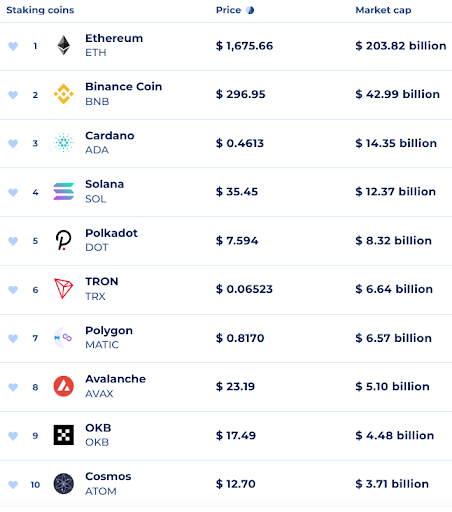Introduction to Staking
Overview
As a crypto portfolio manager or crypto investor, it is imperative to understand what is meant by staking. In crypto, staking refers to the act of locking coins into a smart contract to earn a rate of return colloquially referred to as staking rewards. The reward is similar to the interest rate earned from a typical savings account or certificate of deposit (CD). However, it is different with crypto because the earnings from staking can come in many forms, such as more of the coin that was initially deposited into the smart contract, a different coin/token altogether, or a combination. There are also different lockup periods and, oftentimes, greater rewards associated with longer lockup periods.
The Annual Percentage Yield (APY) generated by staking crypto assets can vary widely across projects, and this attribute is in stark contrast to traditional finance (TradFi) which offers a narrow set of investment options directly accessible to retail investors, and there is little variance in APY across the TradFi retail investment options - Sometimes less than a 1% APY difference between a savings account and certificate of deposit (CD). Some of the differences between staking crypto assets versus depositing cash into a non-qualifying TradFi investment can be explained by the utility generated through staking.
Why Does Staking Exist?
When a blockchain offers staking rewards, the incentive created by the reward mechanism could generate additional demand for the blockchain/project’s coin. That is because, by definition, if someone wants to receive the staking reward APY, then they are required to stake tokens to earn the rewards. Again, it is completely optional and similar to taking advantage of a traditional bank’s savings account or CD interest rate. More importantly, the staking rewards exist to support a more important function of staking - the Proof of Stake (PoS) consensus mechanism.
Proof of Stake is a consensus mechanism and staking is the reward to those who want to allocate their coins to the validators of a blockchain. Recall that validators are a network of distributed computers that secure and add blocks to a blockchain by validating new transactions. The other method you might have heard of in relation to Bitcoin is Proof of Work. In the Proof of Stake model, validator nodes are randomly chosen to validate transactions and append them to the blockchain. The most common validator node selection methodology prioritizes nodes with the highest amount of staked coins, or the selection methodology could be random which is the ultimate plan of the Ethereum Beacon PoS post-merge chain. Or, a different selection methodology could be used altogether since it is software-defined and possibilities are nearly limitless. To learn more about the planned improvements for the Ethereum blockchain, check this article where we take a deeper look: Ethereum’s Blockchain Improvements
A predetermined amount of coins is required for a node to perform validator duties, and the validator node receives a reward in return for validating and appending new transactions to the blockchain. The validator nodes can, in theory, be trusted because submission of an invalid transaction to a blockchain is penalized by the loss of staked coins, a.k.a slashing.
Popular Staking Rewards
There are a few filters that we can use while viewing projects that offer staking rewards, and they may help inform crypto investment solutions. Let’s explore a couple.
When projects that offer staking rewards are ranked by market cap, we see a lot of the common layer 1 blockchains. This includes Binance, Cardano, Solana, and Polkadot, to name a few. It also includes Ethereum’s Beacon Chain (not the main chain at the time of this writing), which is operational and has ether (ETH) staked allowing it to be secured by Ethereum’s PoS consensus mechanism. There are a couple of lesser-known tokens such as TRON and OKB. The latter powers utility in one of the world’s largest crypto exchanges.
Blockchains/Project with Staking Rewards ranked by Blockchain/Project Market Cap
However, if an investor is seeking out a project with the highest staking rewards, then the top ten list looks a lot different. Projects with the highest staking rewards are shown in the figure below.
Blockchains/Project with Staking Rewards ranked by Staking Reward APY
There are many projects with rewards of well over 100% annual APY which is impressive, but investors should take a holistic view of a project’s tokenomics before incorporating staking rewards into a broader crypto portfolio strategy. For example, a high staking reward rate without a token burn mechanism ultimately leads to an inflationary token issuance model that will devalue the token, and lead to a decline in the token price. While staking rewards might bring new investors in the door, similar to a heavily discounted item at a store, the utility provided by the token will ultimately retain users and increase the long-term value of a blockchain’s token. Additionally, many high APY staking rewards quickly decline due to the absence of the blockchain’s revenue-generating utility and/or increase in adoption. So, while a high staking reward is initially very attractive, other aspects of a project’s token should be understood such as the token’s total supply, minting schedule, amount in circulation, distribution schedule, burn schedule, and underlying utility, to name a few. On-Chain Index’s DeFi Index contains a number of high-quality blockchains that offer staking rewards: Crypto Mutual Fund Products


